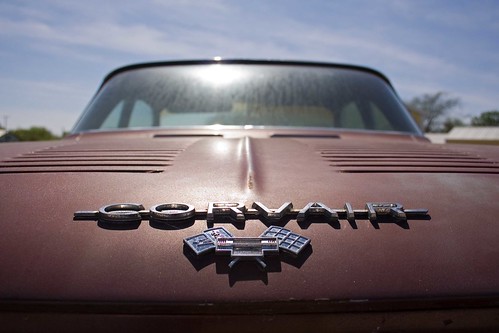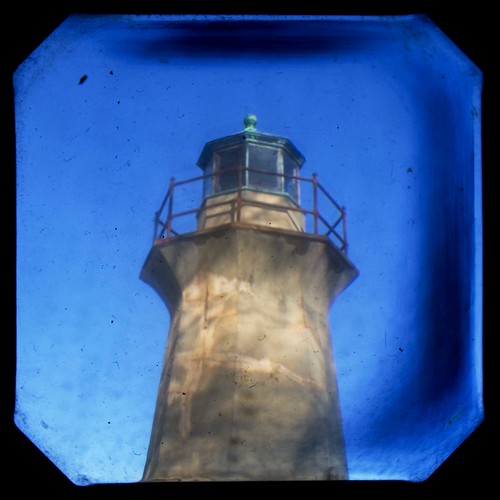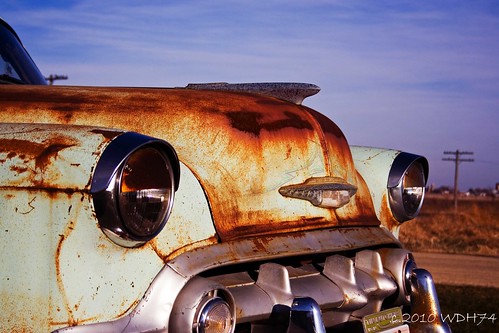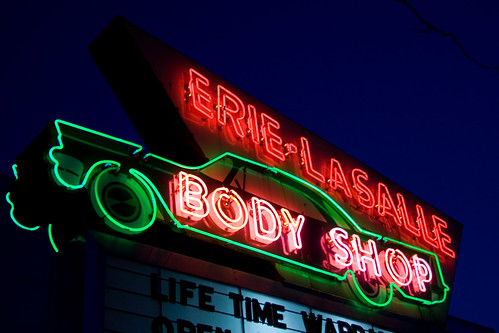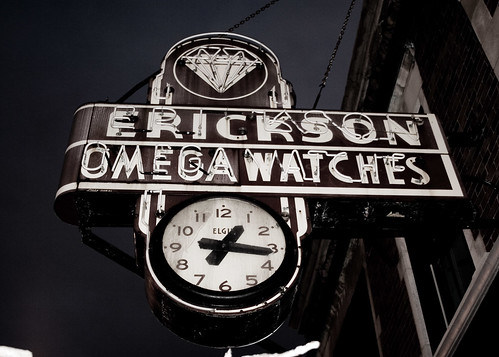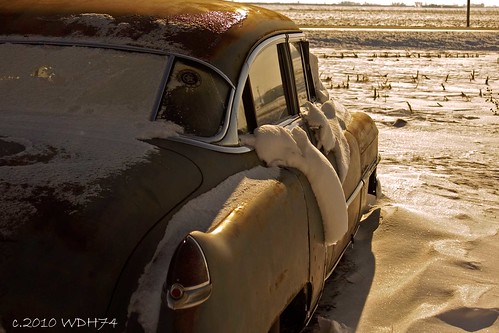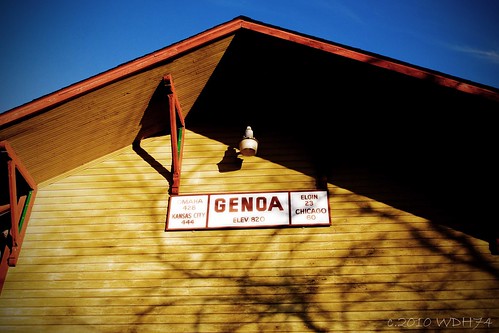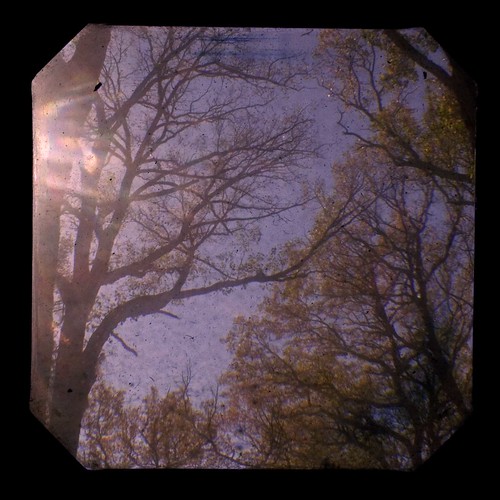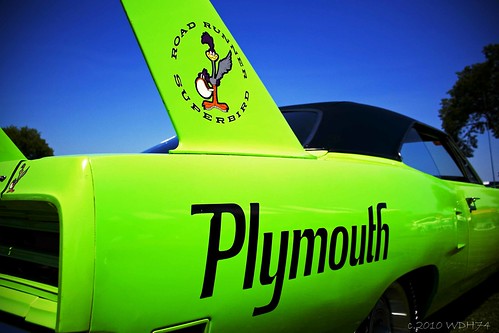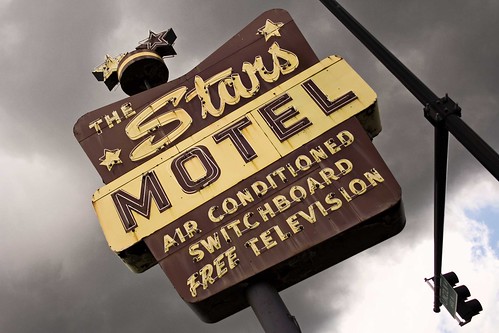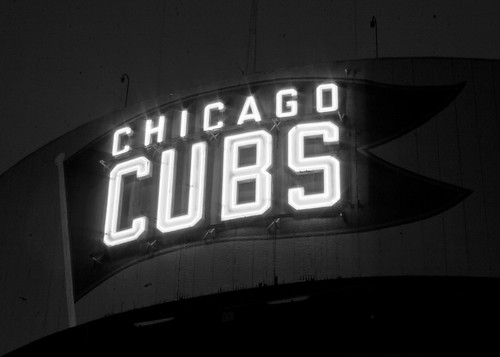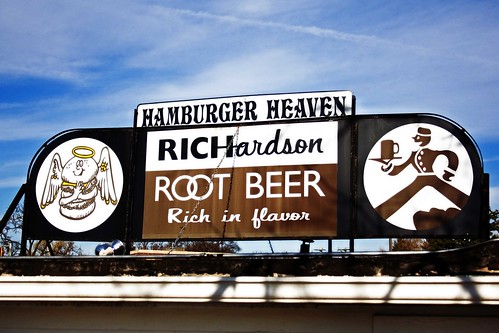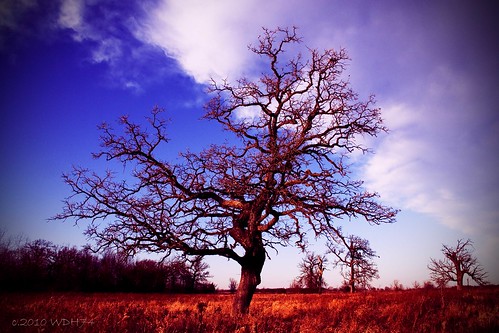Okay, you may recognize that from an old Three Stooges short, but for the second Neon Friday in a row there's a holiday and a distinct lack of holiday themed signage. So I dug out this neon cake, which is at La Baguette Panaderia in Chicago's Andersonville neighborhood.
Happy New Year!
Friday, December 31, 2010
I knew you were coming so I baked a cake!
Thursday, December 30, 2010
Four-H
You used to see these 4-H Club signs more frequently, usually at county lines and sometimes on the outskirts of town, near the signs from the local Rotarians welcoming travelers. They're pretty distinctive, with the club's four leaf clover logo and white and green livery. I don't come across them very often anymore, and I don't even know if they're being made anymore. This one's in rural Illinois, and has a twin on the other side of the county.
4-H clubs have a sort of quaint reputation, mainly because of the organization's rural beginnings, but the 4-H clubs of today have extensive programs dealing in citizenship, science and technology, and healthy living.
Wednesday, December 29, 2010
CFD
Like most big cities (and small ones, as well) Chicago has it's fair share of buildings that were built for one purpose but now serve another. In some cases they'll have been modified beyond recognition, but sometimes an old building will retain some of it's original ornamentation or signage.
This former firehouse is probably one of Chicago's most famous former stations. The former home of Engine Company 42, this great building is easily visible from the L (in fact, it's how I first noticed it, taking the Brown Line down to the Loop) and still retains much of it's fire station characteristics. This includes the CFD sign over the door, the big double doors, and it's characteristically narrow footprint. Originally built in 1888, this station was disused in 1964. Currently it appears to be unused, but is close to being granted landmark status.
Tuesday, December 28, 2010
Lincoln Highway
We return to rural Illinois for today's TtV Tuesday, and one of the original markers for the Lincoln Highway. There are four of them still standing along a one-mile stretch of the road, just outside the town of Franklin Grove. This one's probably my favorite one, because it has some interesting stuff in the background. Of the other three, one has a big chip missing out of it, and is in a bit of scrub ground between two alignments, and the other two front cornfields that look all right when there's something growing but not so much when the fields are bare. I've shot them all, anyway.
Monday, December 27, 2010
Tomorrow's Car.....Yesterday!
Chevrolet's Corvair was one of a new generation of American compact cars being built in the early 1960's to combat smaller imports. However, while Ford's Falcon and Plymouth's Valiant were basically scaled down conventional cars, the 'Vair was a radical clean sheet design. Featuring a rear-mounted, air cooled engine, all independent suspension, and a roomy, flat floored passenger compartment, the Corvair was a sales success for GM, bringing in new customers who previously wouldn't have considered Chevrolet.
It didn't last, though. By the mid sixties sales were falling, and the publication of Unsafe At Any Speed, which featured a chapter on the car's handling, didn't help. But there were other factors at play-GM had already planned on ending production in 1966, so any improvements on the second generation cars were halted at that time. Plus, the 'Vair was facing competition from the newly-formed pony car class- cars such at the Ford Mustang and Chevy's own Camaro steadily ate into Corvair sales. Ironically, the compact sports class was pioneered by the Corvair's own Monza sports model.
This one's a first generation Monza 500. I found it parked in a back lot along Route 66-another fading American icon.
Friday, December 24, 2010
Dog 'N' Suds
Merry Christmas, and Happy Neon Friday! Naturally, I don't have any photos of Christmas themed neon, so I'm taking us on a trip back to the warmer days of summer. A time of fun in the sun, going to the beach, mosquito bites, and a trip to the drive in for hot dogs and frosty root beer.
Dog 'N' Suds restaurants were founded in the '50's in Champaign, Illinois, and at one time were really common here in the Midwest. They were best known for their Coney dogs, a hot dog covered in chili con carne and onions, and for their root beer. And I must say, the root beer at Dog 'N' Suds is pretty damn awesome-very sweet and super creamy. You can find bottles of it in grocery stores around here, but I tell you it's best straight out of the tap.
There are only about fourteen Dog 'N' Suds drive in restaurants left-I have vague memories of going to one when I was very young, but I really am not sure. Anyway this one is in Richmond, Illinois, and has this awesome neon sign out front. Everyone should go!
Thursday, December 23, 2010
A Fine Place To Eat
Old signs that advertise products no longer made, or businesses no longer extant, are called "ghost signs". They pop up in the strangest places, from the big cities to the smallest towns-I've discovered that walking down alleys is a good way to discover hidden gems.
This is a fairly well known ghost sign in Rochelle, Illinois (we've visited Rochelle's restored early Standard station). It used to advertise some sort of food product, probably a soda or beer-the sign says "served and sold at" the Black Cat Cafe. Sadly, the top half of the sign is too deteriorated to read, and the Black Cat is no more, so I can't even go ask.
Wednesday, December 22, 2010
Via Elevated
Tuesday, December 21, 2010
Lighthouse
This lighthouse, like much of the Fabyan estate, has a story behind it. Apparently, Colonel Fabyan tried to get the portion of the Fox River that passed through his grounds closed-the State of Illinois politely declined this request, so the Colonel had this little lighthouse put up. Apparently it used to flash twice, then three times, then twice....and on and on. Like a little two fingered salute to the state. It doesn't work now, sadly.
Edited to correct links.
Monday, December 20, 2010
Motorcar Monday!
Welcome to a new feature here at View. Found., Motorcar Monday! This week we've got another rusty gem, a 1953 Chevrolet sedan delivery. Sedan deliveries were popular for many years, finally falling out of fashion in in the States in the 60's, as vehicles like the Volkswagen Transporter grew in popularity. Interestingly, in Europe, sedan deliveries remained popular, with cars such as the Opel Astra getting the panel treatment
. Sedan deliveries are basically two-door station wagons, with the side windows blanked off and a swing-out loading door on the back. With Spartan interiors and often only a driver's seat, they were ideal for small merchants and tradesmen such as plumbers and electricians. Consequently, most of them lived hard lives and survivors are rare. This rusty but proud example is parked in front of a rural hot rod shop, and has had a few custom touches added onto it. I'd love to save it.
Friday, December 17, 2010
Body Shop
One of my favorite neon signs in Chicago is this one for the Erie-LaSalle Body Shop. It's right downtown, on Erie near the McDonald's. I like the jutting wedge at the top and the outline and the outline of the big Chevy. A lot of neon signs look pretty good in the daytime as well as lit up at night, but this isn't one of them-it really comes alive with the tubes lit up.
*Programming Note! I've moved a couple of things around and hereby christen this Neon Friday!
Thursday, December 16, 2010
Kinzie Street Bridge
The first rail bridge at Kinzie Street in Chicago was built in 1852, allowing trains access to the Galena and Chicago Union Railroad's Wells Street station. A swing bridge replaced it a few years later, and this one opened in 1908. The G&CU became the Chicago and North Western, which closed the Wells Street station in 1911, and this bridge reverted to handling freight only. This line originally went all the way to Navy Pier, but latterly it handled shipments for the Chicago Sun-Times' printing facility, which moved in 2001. Since the Times was the last customer using the bridge, it was permanently raised.
The Kinzie bridge is a single leaf bascule bridge, and at the time of it's building was the longest and heaviest in the world. It was granted landmark status in 2007, and has remained as a monument to Chicago's railroading heritage. Amazingly (to me, at least) a lot of the infrastructure still exists. The tracks and signals are still there on the other side of the river, as does this signal on the Sun-Times side. Presumably it could be made operative, despite the rust, graffiti, and broken windows in the control house.
Tuesday, December 14, 2010
Winter Wonderland
Back at the Japanese Tea Garden in Batavia, for this chilly, wintery TtV Tuesday. I do like shooting here-being a garden it changes with the seasons, from the lush greenery of summer to the peaceful snow cover of winter.
I ran this through the Faux-Vin Genuine Artificial Aging widget for that "found in a shoebox in the attic" look.
Monday, December 13, 2010
Studebaker Service Station
This is a small garage in the town of Lindenwood, Illinois. It's been in business for many years, and I understand that the proprietor specialized in Studebakers back when Studies were still being made. I don't know if this little shop was ever a dealer, however. Sadly, the owner seems to have passed away recently, and the fate of this little shop is unknown.
Erickson Jewelers
Interestingly, I think this was a sort of pattern sign from the company-a similar sign hangs in front of a jewelry store in Woodstock, Illinois.
Saturday, December 11, 2010
Semaphore
Semaphore signals were patented in the 1840's, and went on to become the most widely used type of trackside signals in much of the world. Meant to provide a visual signal to train drivers, they utilize both the position of the arm, as well as the illuminated lenses to get their message across. Although still common in Britain, semaphore signals are mostly extinct along American rails, with only a few branch lines in the Midwest still featuring them. However, they are still to be found here and there, preserved in front of former depots, in towns with a railroad history, and in museums.
This example is in front of the former Milwaukee Road depot in Genoa, Illinois.
Friday, December 10, 2010
When you're out of Schlitz, you're out of beer
A tied house is-or was-a pub or tavern that is contractually obligated to sell beer from a certain brewery. Often this was done for economic reasons-in Chicago tied houses rose in number when license fees were raised so high that bar owners turned to breweries for financial help. Breweries would supply everything needed to run a saloon, and in return they'd only serve that company's beer. Tied houses in the United States were mostly legislated out of existence following Prohibition, when a three tiered system of alcohol distribution was instituted-manufacturers could only sell to distributors, who could only sell to retailers, none of whom could have an interest in the other.
In Chicago, the biggest builder of tied houses was Schlitz of Milwaukee. Designed by the architectural firm of Frohmann & Jebsen, Schlitz houses were usually done in a revival style, with cupolas over the front corner and intricate brickwork. Quite a few of them survive today, including such famous ones as Southport Lanes and Schuba's in Lincoln Park. This one's less famous, and is up on Broadway and Winona in the Uptown neighborhood. One of the larger Schlitz houses, it's still in pretty good shape, with it's Schlitz crest still hanging, the back beer garden still in existence, and a non-working "restaurant" neon sign over the front door. It's not longer a restaurant or tavern, though, and serves as a community center for the neighborhood.
Thursday, December 9, 2010
Snowy Glory
Actually, I need to take several more, since I came up with the grand idea to take a bunch of pictures from similar angles, but in different weather conditions and seasons. This is the second in the series, and is meant to resemble this shot I took in the fall.
*Edited to correct link.
Wednesday, December 8, 2010
Genoa Station
Once upon a time, you could go just about anywhere in the country on a train. Stations and whistle stops dotted the countryside, and the local depot was both a lifeline and a meeting place. Times have changed, of course, and most towns are accessible by road these days, and the number of cities serviced by passenger rail has decreased dramatically.
Many of the old stations and depots still stand, though. This one is a former Chicago, St. Paul, and Milwaukee station in Genoa, Illinois. The Milwaukee Road ran plenty of passenger trains out of Chicago to points west, including the famous electrified route through the Rockies. This station likely handled some Hiawathas, as well as locals into Chicago and to points north. It is nicely restored and is in use as a museum.
Tuesday, December 7, 2010
T(ree)tV Tuesday!
Another Through the Viewfinder shot. This is a bunch of trees, at the park. I'm honestly not sure which park-I think it's near the Japanese gardens I've shown you. But I really like this photograph, as I think it encapsulates everything that makes TtV photography so interesting-dust and crud, wierd reflections, out of focus edges, and an odd bit of lens flare that doesn't quite match up with the accepted styles of lens flare. For added flavoring I ran it through the Faux-Vin Genuine Artificial Aging Machine to give it that "expired off-brand film" look.
Monday, December 6, 2010
I'm a Road Runner, Honey
One of the reasons that Mopar muscle of the late sixties and early seventies-aside from the often dramatic styling and the big block motors-is the impressive array of bright colors they were available in. This Plymouth Road Runner Superbird combines all three-wild looks, a 440 Six Barrel, and an eye-watering color called Lime Light.
The Superbird (and it's slightly older cousin the Dodge Charger Daytona) is probably the best known muscle car ever produced. They're quite rare-less than 2,000 of them were made for just one year-and very dramatic, with their pointy noses and that sky high wing. Originally designed to homologate the areo bits for NASCAR racing, the Superbird was a sales failure-the styling was too dramatic for most peoples' tastes, and the standard Road Runner was cheaper and faster on the quarter mile. New examples were still to be found on dealer lots as late as 1972, heavily discounted.
Always a popular car, the 'Bird has had a resurgence thanks to the character "The King" from the movie Cars, which was clearly meant to be Richard Petty's iconic blue 1970 race car.
Sunday, December 5, 2010
The Stars
Every big city has it's motel row, and Chicago's was along Lincoln Avenue, in the West Ridge neighborhood. They had cool mid century architecture and funky old signs out front, with a distinct whiff of off-strip Vegas mixed in. Most of them are gone now, but a few are hanging on.
The Stars is an empty lot, having closed several years ago, but the awesome neon sign has hung on, looking out on Lincoln Avenue's traffic. This Googie-licious sign must have been quite a sight all lit up at night, although I understand that the Stars itself was a seedy dump.
You can tell a really old sign when it's got out of date nomenclature. Air conditioning is still kind of standard on older signs, but free television? When'd they stop having coin-op teevees? The sixties? The switchboard makes me wonder if there was an actual PBX in the office, and if it was still there, but disconnected, when the Stars was demolished.
Saturday, December 4, 2010
The Old And The New
This shot of 1995 was taken in West Chicago, which is about thirty miles west of Chicago. Originally a depot on the CNW's main line, there is still a Union Pacific yard, as well as a passenger depot that is served by Chicago's Metra commuter rail service. The signal bridge in the background is a rare CNW-era Type E signal. Sadly, while the bridge still stands, the lights have been changed to more modern ones.
Friday, December 3, 2010
Wrigley Noir
Throughout the years, Wrigley has managed to retain most of the quirks and features that define it's resolutely old-fashioned character. Open bleacher seats, a manual scoreboard, it's resolutely inner-city neighborhood locale (no seas of parking lots here! Take the L!) all help make Wrigley a unique experience. Another of these features is at the corner of Waveland and Sheffield Avenues-a big wood wall with a pennant painted on it, and the team's name picked out in neon. Most people head over to the famous red marquee sign on Clark, but I've always favored this side. It looks great as the L train goes by at night (see it in color here).
In memory of Ron Santo, 1940-2010.
(Edited to correct links)
Thursday, December 2, 2010
Rich in Flavor
Like sodas, there are (or were) hundreds of different root beer brands being produced all over the country. Some were available in stores, some just at hamburger stands and soda fountains. Richardson appears to be the latter-I can't find a whole lot of information about them, other than a few online auctions for Richardson mugs and stuff, and some other photos of hamburger stands with Richardson signs on them.
The Hamburger Heaven is one such place, and I'd like to try it when it reopens in the spring.
Wednesday, December 1, 2010
Tree
I took this the same day as Uncovering The Sky, after the clouds had moved over.




